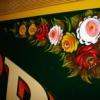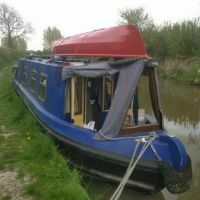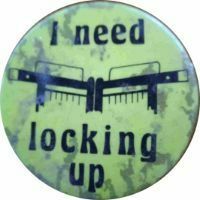

Steve Priest
Member-
Posts
159 -
Joined
-
Last visited
Profile Information
-
Gender
Male
-
Occupation
Boatbuilder
-
Boat Name
Aquila & Bingley
-
Boat Location
Grand union
Recent Profile Visitors
6,415 profile views
Steve Priest's Achievements
Collaborator (5/12)
103
Reputation
-
My apologies for not replying earlier, I have been away. Bob’s painting is quite distinctive ( most peoples work is in it’s own way). Petal shape, colour, layout, I am quite sure that it is his work
-
Sometime back in the mid 1980’s a chap called Bernie Fletcher bought Bognor (which was then unconverted, JP2 powered and kept in Gas street) He brought it to the Warwickshire Flyboat for conversion and fitting out. He had some fairly unsympathetic ideas that we had to live with, it was he who took the JP out and fitted the Perkins, and if I remember correctly he made and fitted the funnel himself. He didn’t have access to an old one to measure and copy, and did it from photographs
-
Retirement has so far been very much like being at work, the transition was seamless!
-
It’s a fascinating job to do as well, you can learn so much about the way they are put together by taking them apart! I have owned Bingley since early 1977, when I was still in my teens (just), first as a camping boat, eventually as a houseboat with a full conversion. Now I have retired the plan now is to deconvert and restore, starting at the fore end. I am intending to do a blog about it, I’ll keep you posted
-
I’m sorting out the fore end plating on Bingley at the moment, here’s a view from a similar angle! And another
-

Polyvine Scumble Oil Discontinued
Steve Priest replied to DShK's topic in Boat Building & Maintenance
I’ve never had much stale beer, but Doom bar must be brewed for a reason! -

Polyvine Scumble Oil Discontinued
Steve Priest replied to DShK's topic in Boat Building & Maintenance
It would seem that it might well be -
Steve Priest started following Water can - can anyone help as to possible painter, or origin? , Polyvine Scumble Oil Discontinued , Painter on a Pair of Cabin Stools ... and 1 other
-

Polyvine Scumble Oil Discontinued
Steve Priest replied to DShK's topic in Boat Building & Maintenance
That’s a blow, and surprising, it is used in other broken colour effects such as rag rolling, stippling, flogging, dragging and marbling as well as graining, so I would have thought that there was enough demand for it. I suppose they would suggest using acrylic, but I would think that the workable time might be a problem. I have never tried to make an oil glaze, but as far as I know it is made of REFINED linseed oil ( not raw or boiled ), white spirit, and china clay ( kaolin or fuller’s earth) to give it body, and a little terebine to reduce the drying time. You can add whatever pigment you want, but for oak you only need raw umber. If you want to alter the shade alter the buff, not the scumble. I tend to use Dulux oil based eggshell as a buff, which is available in loads of different shades, but also benefits from a bit of terebine to reduce drying times The use of water based glazes is, and always has been, common in graining, either on its own or in combination with an oil glaze. When using a water glaze you can’t grain it immediately, you have to wait until it starts to go off, and then work fairly quickly before it dries completely, easy enough on a horizontal surface but It can be a challenge on a vertical surface. When it is dry you can overgrain with an oil glaze straight on top of it, but to overgrain in another water glaze it needs to be varnished first If you try to use a water glaze on a freshly painted oil based buff the glaze will form droplets on the surface, which will need to be degreased. This is done by rubbing it fairly hard with a damp sponge and plenty of fuller’s earth What I am describing is the use of water glazes as they have been used for years. I have never used acrylics, but I would expect them to work, and work more easily than old fashioned water glazes, but I can’t imagine that they will be a complete substitute for oil glazes. If anyone is interested in looking at graining in more detail I would recommend ‘Parry’s graining and marbling’ which is the standard text book on the subject, written in the 1940’s but reprinted since -
We did a lot of work to Fenny some years ago just after Chris Johnson bought her. I can’t remember exactly when, but my guess would be around 2002. There was an extension cabin fitted at the time, I don’t know if this was a waterways cabin or one fitted post waterways, but Mark Holtham had done a fair bit of work on it for a previous owner. I bought the back end rail off Mark, which he had taken off as part of his work , and I modified it and fitted it to Aquila. The extension cabin had been cut off by the time Chris got her to Brinklow. We did a lot of plating to the fore end, refooting from the mast to the stem post fairly high, I think we replaced the front deck, and definitely fitted the front cants and a new deck lid. We did some rebottoming but I can’t remember how much, my guess would be that we refooted and rebottomed from the engine room forwards. We also did a fair bit of plating to the counter and swim, and then fitted the back deck, back cants, gunwhales, back cabin, repairs to the engine room, and the new engine room roof I also had to make and fit a new back end rail to replace the one that I had used on Aquila some time before. Chris owned and lived on the Greenlaw, and used Fenny as a coal boat, I think he had ‘Fenny Fuels’ written on the cabin. The present extension cabin was fitted when he sold her, but not at Brinklow.
-
I did, but Unsuccessfully
-
Looks like Judy Vedmore to me
-

boathorse feed bucket - any ideas about this one?
Steve Priest replied to davidwheeler's topic in History & Heritage
I have a set of three water cans which were painted by the same person, and appears to be the same person that painted my tin and your nose tin, which are unfortunately in poor condition. They all have “Mrs Harrisson (sic) July 1910 “ written around the waist. There is a castle panel on the 3 gallon one that is unmistakably Braunston painted, the style and layout of the castle is typical of castles seen in the later work of Frank Nurser. Age wise Frank could have been painting in 1910, was there anyone else painting in Braunston at that time? I have no idea. And this is a picture of Ann Stokes, who married Richard Harrison in the summer of 1910 I have some better pictures of the cans, but the files are too big to post -

boathorse feed bucket - any ideas about this one?
Steve Priest replied to davidwheeler's topic in History & Heritage
Here are a couple of pictures of a tin that I have that seems to have been painted by the same hand. Phil Speight thought that it was an early example of Frank Nurser’s work, before it evolved into his more recognisable style. Both my tin and your nose tin have a pink rose, which are not anywhere near as common as the usual red, white, and yellow. I think that we will never know for sure whether it was Frank Nurser’s work, but perhaps one thing that we can be fairly sure of is that it was painted at Braunston -
It seems to me that the paintwork is in good condition, but the varnish has gone dark. If you were to VERY carefully strip the old varnish back you would find that it would really come to life. After that, give it a good polish with carnuba wax, or varnish it with artists picture varnish which would give it some protection, but is designed to be easily removed
















